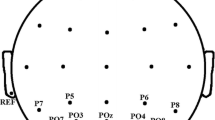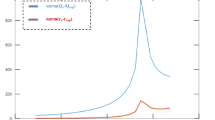Abstract
In this paper, we introduce a new modelling related parameter called region of interest sensitivity ratio (ROISR), which describes how well the sensitivity of an electroencephalography (EEG) measurement is concentrated within the region of interest (ROI), i.e. how specific the measurement is to the sources in ROI. We demonstrate the use of the concept by analysing the sensitivity distributions of bipolar EEG measurement. We studied the effects of interelectrode distance of a bipolar EEG lead on the ROISR with cortical and non-cortical ROIs. The sensitivity distributions of EEG leads were calculated analytically by applying a three-layer spherical head model. We suggest that the developed parameter has correlation to the signal-to-noise ratio (SNR) of a measurement, and thus we studied the correlation between ROISR and SNR with 254-channel visual evoked potential (VEP) measurements of two testees. Theoretical simulations indicate that source orientation and location have major impact on the specificity and therefore they should be taken into account when the optimal bipolar electrode configuration is selected. The results also imply that the new ROISR method bears a strong correlation to the SNR of measurement and can thus be applied in the future studies to efficiently evaluate and optimize EEG measurement setups.





Similar content being viewed by others
References
Andrews TJ, Halpern SD, Purves D (1997) Correlated size variations in human visual cortex, lateral geniculate nucleus, and optic tract. J Neurosci 17(8):2859–2868
Celesia GG, Bodis-Wollner I, Chatrian GE, et al (1993) Recommended standards for electroretinograms and visual evoked potentials. Report of an IFCN committee. Electroencephalogr Clin Neurophysiol 87(6):421–436
de Munck JC, Vijn PC, Lopes da Silva FH (1992) A random dipole model for spontaneous brain activity. IEEE Trans Biomed Eng 39(8):791–804
Di Russo F, Martinez A, Sereno MI, et al (2002) Cortical sources of the early components of the visual evoked potential. Hum Brain Mapp 15(2):95–111
Di Russo F, Pitzalis S, Aprile T, et al (2006) Spatiotemporal analysis of the cortical sources of the steady-state visual evoked potential. Hum Brain Mapp
He B, Yao D, Lian J (2002) High-resolution EEG: on the cortical equivalent dipole layer imaging. Clin Neurophysiol 113(2):227–235
Hoekema R, Wieneke GH, Leijten FS, et al (2003) Measurement of the conductivity of skull, temporarily removed during epilepsy surgery. Brain Topogr 16(1):29–38
Ikeda H, Nishijo H, Miyamoto K, et al (1998) Generators of visual evoked potentials investigated by dipole tracing in the human occipital cortex. Neuroscience 84(3):723–739
Lai Y, van Drongelen W, Ding L, et al (2005) Estimation of in vivo human brain-to-skull conductivity ratio from simultaneous extra- and intra-cranial electrical potential recordings. Clin Neurophysiol 116(2):456–465
Lutkenhoner B (1998) Dipole source localization by means of maximum likelihood estimation I: theory and simulations. Electroencephalogr Clin Neurophysiol 106(4):314–321
Lutkenhoner B (1998) Dipole source localization by means of maximum likelihood estimation: II. experimental evaluation. Electroencephalogr Clin Neurophysiol 106(4):322–329
Malmivuo J, Plonsey R (1995) Bioelectromagnetism: principles and applications of bioelectric and biomagnetic fields. Oxford University Press, New York
Malmivuo J, Suihko V, Eskola H (1997) Sensitivity distributions of EEG and MEG measurements. IEEE Trans Biomed Eng 44(3):196–208
Malmivuo JA, Suihko VE (2004) Effect of skull resistivity on the spatial resolutions of EEG and MEG. IEEE Trans Biomed Eng 51(7):1276–1280
McFee R, Johnston FD (1953) Electrocardiographic leads I: introduction. Circulation 8(4):554–568
Neilson LA, Kovalyov M, Koles ZJ (2005) A computationally efficient method for accurately solving the EEG forward problem in a finely discretized head model. Clinical Neurophysiology 116(10):2302–2314
Niedermeyer E, Lopes da Silva F (1993) Electroencephalography: basic principles, clinical applications, and related fields. Williams and Wilkins, Baltimore
Nunez P (1981) Electric fields of the brain: the neurophysics of EEG. Oxford University Press, New York
Oostendorp TF, Delbeke J, Stegeman DF (2000) The conductivity of the human skull: results of in vivo and in vitro measurements. IEEE Trans Biomed Eng 47(11):1487–1492
Raz J, Turetsky B, Fein G (1988) Confidence intervals for the signal-to-noise ratio when a signal embedded in noise is observed over repeated trials. IEEE Trans Biomed Eng 35(8):646–649
Rush S, Driscoll DA (1969) EEG electrode sensitivity—an application of reciprocity. IEEE Trans Biomed Eng 16(1):15–22
Vanrumste B, Van Hoey G, Van de Walle R, et al (2001) The validation of the finite difference method and reciprocity for solving the inverse problem in EEG dipole source analysis. Brain Topogr 14(2):83–92
Watson JDG (2000) The human visual system. In: Toga AW, Mazziotta JC (eds) Brain mapping: the systems. Academic Press, San Diego, pp 263–289
Väisänen J, Hyttinen J, Malmivuo J (2006) Finite difference and lead field methods in designing implantable ECG monitor. Med Biol Eng Comput 44(10):857–864
Acknowledgements
We would like to thank Robert MacGilleon for English proofreading. The work has been supported by grants from the Pirkanmaa Regional Fund of the Finnish Cultural Foundation, the Emil Aaltonen Foundation, the Foundation of Technology Finland and the Ragnar Granit Foundation.
Author information
Authors and Affiliations
Corresponding author
Rights and permissions
About this article
Cite this article
Väisänen, J., Väisänen, O., Malmivuo, J. et al. New method for analysing sensitivity distributions of electroencephalography measurements. Med Bio Eng Comput 46, 101–108 (2008). https://doi.org/10.1007/s11517-007-0303-x
Received:
Accepted:
Published:
Issue Date:
DOI: https://doi.org/10.1007/s11517-007-0303-x




